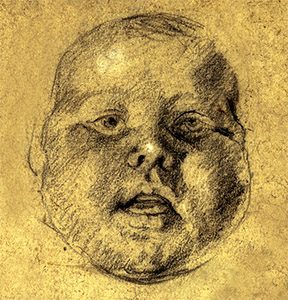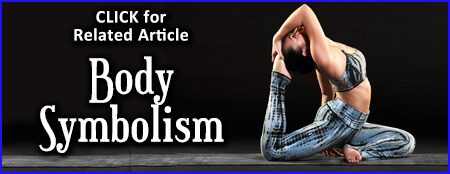
Cheek Meaning: Idioms and Symbolism
Cheek meaning is revealed clearly in the language that we use to describe our bodies. These meanings are part of our everyday consciousness and interactions. A single part of the body can be heavily laden with many different meanings. Sometimes the meanings are highly amusing as well! This is particularly true of the cheek: the fleshy part of the face on either side of the nose between the eyes and ears.
Share this page with a friend!
Defining the Cheeks
In addition to the cheeks on the side of the face, the word “cheek” can also refer to the buttocks. In fact, “cheek” can be used for anything resembling a cheek in shape or position. The cheeks are a prominent part of the face, representing a portion of your identity to the world. Your face reveals your innermost emotions and thoughts.
Facial Expression and the Cheeks
Your expression is largely conveyed by the muscles of the cheeks. Are the muscles tight and tense? Is the shape of the face relaxed or distorted? Can you feel whether you are conveying happiness or bitterness? Interestingly, the cheeks are connected to an array of contrasting emotions: acceptance (as in “turn the other cheek”), humor (“tongue-in-cheek”), and impudence (“cheeky retort”).

Cheek, Mouth and Lip Meaning
The cheeks, mouth and lips are prime candidates for both deep and lighthearted meanings. As a central part of our self-expression, these body parts are the subject of numerous idioms and metaphors. Mouth meaning taps into the entire world of emotions and self-expression. The mouth is possibly the most psychologically conflicted feature of the face.
The Amazing Versatility of the Mouth
The mouth is a central focus for both receiving and giving pleasure and pain. We use the mouth to take in food and drink, to praise and curse, to kiss and spit, to sing and to moan. We speak up for ourselves, mouth off, purse our lips, grin, pout, whistle, grimace, frown, mumble and chew.
Idioms and Metaphors: Cheeks and Mouth
As a central part of our self-expression, the cheeks, mouth and lips are the subject of numerous idioms and metaphors. The mouth can be funny, sad, and everything in between. How we hold our mouth has a direct impact on the tension or relaxation in the rest of our bodies. The list below is a sample of these idioms and metaphors associated with the mouth and cheeks.
Cheek Meaning
Cheek by jowl: intimate, closely related or in close proximity
Cheeky: talk or behavior that is impertinent; insolent, bold, cocky and disrespectful
Cheek to cheek: close and affectionate
Rosy-cheeked: a vigorous and healthful appearance
Water one’s cheeks: to cry
Mouth Meaning
All mouth and no trousers: to talk without taking action
Butter wouldn’t melt in his/her mouth: a person who looks innocent but is not
Down in the mouth: filled with despair, gloomy, discouraged
Foam at the mouth: be extremely angry
Live from hand to mouth: spend everything for necessities
Make a mouth: grimace or express dislike
Make your mouth water: something so attractive that you respond viscerally
Mouth off: to speak indiscreetly or impudently
Put your money where your mouth is: give financial support
Take the words out of someone’s mouth: say exactly what they were going to say
Say a mouthful: a lengthy remark or monologue
Lip Meaning
Bite your lip: hold back what you’d like to say, refuse to cry
Give someone lip: talk back disrespectfully
Lip service: talk as though you support something but do nothing
My lips are sealed: I won’t tell anyone
On everyone’s lips: everyone is gossiping about a topic
Read my lips: figure out what someone is saying without hearing them
Smack your lips: show eagerness or excitement
Stiff upper lip: not letting anyone know how you feel
Tight-lipped: lips pressed together to avoid expressing pain, anger or one’s opinion
Human Emotions & the Cheeks, Mouth and Lips
The mouth and the eyes are the most expressive features on the human face. We cover our mouths when we cry or cough. Many people have the habit of covering their mouth or putting their hands to their cheeks when they are surprised or embarrassed or simply don’t know how to respond. A man can hide a “weak mouth” with a mustache and a beard. A woman’s mouth is nearly always visible.
Your Expressive Mouth
The meaning of “down in the mouth” gives clues to the related emotional state: discouraged, sad, dejected, gloomy, taking a grim view of life, dispirited, resigned, downcast, downhearted, discouraged, depressed, moping, sagging, or dejected but trying to look cheerful.
Emotional Patterns and the Mouth
The opposite emotional pattern is also be true. Someone who is joyful but does not feel that the expression of positive emotions is appropriate may also train themselves to hold that tension in their mouth. Did someone in authority ever say to you, “Wipe that smile off your face! Did you think I said something funny?”
The Problem with a Smile
We want to be taken seriously in life, not to be seen as some shallow joker with a “stupid grin.” Will people think we are working hard enough if we are always smiling? Will our co-workers take us seriously? Will people think we are naïve, ignorant and silly if we smile too much?
The Price of a Tight Mouth
Whether you have spent a lifetime trying not to cry or trying not to smile or both, your cheeks and mouth have been affected by your personality, your psychology and your reactions to life. When you tighten your lips to mask the expression of emotion, the lines begin to form and the lips begin to thin. We tighten our mouths in judgment of others and in judgment of ourselves.
Symbolism of the Cheeks, Mouth and Lips
The mouth is a boundary between ourselves and the world. Ideally, we have a balance between our ability to take in what we need for our own well-being and our ability to nurture others with our words and expressions. Symbolically, a mouth means any cavity or opening such as the mouth of a river, a cave, a harbor, a tunnel or a canyon. A jar has a mouth. A volcano has a mouth. Pipes have mouths. So do guns and musical instruments.
Gateway to Nourishment
The mouth is the gateway to nourishment and the source of speech and song. Pouches or drooping around the mouth can indicate deep disappointments, a conflict between wanting to be a martyr for others and demanding that others support you, and problems with self-esteem, self-righteousness or self-acceptance. To return to a soft, open, unlined mouth, you may want to analyze these patterns in yourself.
Language and the Mouth
Our language and expressions reflect how closely we identify ourselves with our cheeks, mouth and lips: he has three mouths to feed at home; she gave mouth to her doubts; he was the mouthpiece of the devil; she got the news straight from the horse’s mouth; her mouth was her own worst enemy; he was mouthing empty compliments; she was just mouthing the opinions of the candidate; she mouthed soundlessly as fear overtook her; don’t give me any lip; bite your lip (to stop from speaking); grin and bear it; watch your mouth
Affirmations for the Cheeks, Mouth & Lips
Of all the things you wear, your expression is the most important! The affirmations below are related to the psychological role of the cheeks, mouth and lips in assimilation, nurturing, self-assertion and self-confidence. Affirmations are a wonderful way to reinforce positive thoughts and weed out your negative self-talk.
Using a Mirror for Affirmations
Even repeating five minutes a day in a mirror will do wonders for your self-awareness and begin to change deeply-embedded thoughts. Always keep in mind that a trained counselor or coach is a wonderful ally for your growth and success.
Affirmations for Assimilation
I welcome and digest new ideas and experiences easily.
My intake and assimilation are in perfect order.
I absorb all that I need and release the past with joy.
Affirmations for Nurturing the Self
I nurture my soul with divine inspiration.
I nourish myself with love.
I accept my need for physical and sexual pleasure.
I take childlike delight in the pleasures of life.
Affirmations for Self-Assertion
I easily ask for what I want and life supports me.
I trust my decisions and communicate optimistically.
I share my full range of emotions in an appropriate way.
Affirmations for Confidence
I find pleasure, laughter and confidence within myself.
I am at home in my life, handling unexpected events with ease.
I balance my emotions with problem solving and practical thinking.
Explore our article on Five Element Mantras.
Oriental Facial Diagnosis
In the Oriental system of diagnosis, the mouth and lip area shows the condition of the digestive system. The cheeks are related to the health of the lungs. The mouth indicates the physical and mental ability to adapt to the environment. The upper lip indicates the condition of the upper part of the digestive system including the stomach. The lower lip indicates the condition of the lower digestive tract, especially the large and small intestines.
Messages in the Shape of the Mouth
The corners of the lips are related to the duodenum. A mouth that is overly wide and large indicates a yin condition, sometimes brought about by overconsumption of sweet or highly processed foods and drink. The use of diet, acupressure, facial massage and exercise can restore a healthy condition for the mouth and support the related organs.
Acupressure for the Face
Corner of Mouth
Press points at the corner of the mouth on both sides for 10 seconds, pushing upwards. Massage in small circular motions to the right and to the left for an additional 10 seconds in each direction. These are stomach points and assist in receiving nourishment from both food and thoughts. Recommended Essential Oils: Use rosemary oil diluted in a carrier oil to massage this point as desired. Rosemary oil restores self-worth and relaxes stiffness and cramping.
Upper Lip
Press the index finger on your upper lip directly under the middle of the nose, halfway between the top of your upper lip and the bottom of your nose. Push gently upward and breathe deeply for thirty seconds. This point assists in the qualities of giving and receiving, balancing masculine and feminine energies. Recommended Essential Oils: Use ylang ylang or pine oil diluted in a carrier oil to massage this point if desired. Ylang ylang helps to clear eating disorders and dispels fear of intimacy. Pine oil restores emotional boundaries and supports the kidneys, bladder and gall bladder.
Exercises for the Cheeks, Mouth and Lips
Exercises can make a huge difference in the appearance of your cheeks, mouth and lips. In addition, the production of sound for singing, chanting or vocalizing involves all of the major muscles of the mouth. The sound resonates in the bones of the face and skull, further stimulating circulation.
Emotional Release of Toning
Besides the physical exercises, the emotional release of producing tones cannot be overstated. The social connection created by singing together is also a healing experience. Singing is akin to an internal face massage, bringing oxygen to the entire face. Learn more about group singing in What is Kirtan? Learn more about mantras in Healing Mantras.
Keeping Your Face Moist for Exercises
Before beginning face exercises, you may want to moisten your face with a natural lotion or diluted essentials oils. Essential oils recommended for the skin include lavender essential oil, carrot seed essential oil, grapeseed oil and rosemary essential oil.
Exercise Descriptions
All Around the Mouth: Place your index fingers in each corner of your mouth, opening the mouth to a comfortable level but not stretching the mouth. Tighten the muscles to pull your fingers towards each other about a quarter of an inch. Resist with your fingers . Hold for a second or two. Tighten the muscles even more strongly to pull your fingers another quarter of an inch closer. Hold for another second or two. Repeat ten times, holding the final position as tightly as you can for thirty seconds. This exercises mainly works the Orbicularis oris and helps to remove lines around the mouth.
Corners of the Mouth: Place the tips of your index fingers in each of the corners of your mouth. Now press the lips together and then tighten the muscles in the corner of the mouth and try to pucker the lips together while resisting with the pressure of your fingers. Hold to the count of ten. Relax. Repeat ten times, holding the final repetition to the count of thirty. This exercise works the Zygomaticus muscles and helps to eliminate sagging at the corners of the mouth.
Lip Plumper: Place your three middle fingers of one hand on your lips positioned in each corner and in the center of the lips. Use the pad of each finger and not the tip. Purse your lips and protrude them, resisting with your fingers to keep the lips spread and prevent lines from forming above the upper lip. Hold to the count of five. Relax. Repeat ten times, holding the last repetition to the count of thirty.
Lip Curler: Curl your upper and lower lips into your mouth so they are no longer visible. Squeeze them together as though you are tightly squeezing a slice of orange, flaring your nostrils down and pulling your chin upwards. Hold for a count of ten. Relax. Repeat ten times, holding the final count for thirty seconds.
Lower Lip Gymnastics: Pull your lower lip down to expose your bottom teeth. Hold tightly for five seconds. While maintaining this tension, move your lower jaw forward and hold for five more seconds. Now move your tongue to the roof of your mouth and hold for a final five seconds. Relax,. Repeta ten times, holding the final count to thirty seconds.
Hidden Smile: Pull your lips over your upper and lower teeth into your mouth. Pull up both corners of your mouth into a smile, rasing your cheeks and holding for ten seconds. Repeat ten times, holding the last upward position for thirty seconds.
From the Inside Out: Relax your jaw, letting it hang loosely down. Sing or say AAAAH, then lift your jaw and round your lips slightly to transition to OOOOOOOO. Finally, close your mouth gently and chant MMMMMMM. This process should take ten to thirty seconds. Now blend the sounds together more quickly, repeat the three tones and taking a break in between for ten repetitions.
The Power of Vowels: Look in the mirror and say all five vowel sounds in an exaggerated and well-enunciated way, hold each sound for about a second. Repeat ten times.
Other resources on the web: How to Draw a Face
Author Kathleen Karlsen
Kathleen Karlsen is a musician, artist, writer and speaker. She is the author of two books (Flower Symbols and Vocal Medicine) and over 200 articles. Kathleen, her husband Andrew, and their five children live in Bozeman, Montana. More about Kathleen Karlsen.





